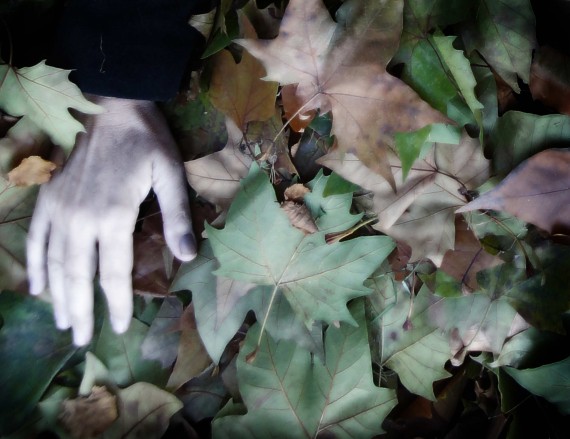gender after thoughts
2. 10. 2013 // Robert Steijn // Kategorie Randnotizen 2013I am sitting in the train back to Amsterdam. Thinking of the forest in Peggau makes me melancholic. I feel relieved. But there is also a lot to think, before we translate this piece into an indoor version in the theatre Brut in December.
Some people mentioned a political incorrectness in how we worked with only one woman in an overall male cast. Even the fact that she wore a bra, was interpreted as a political incorrect statement.
It was clear that it was something very dangerous to work with only one woman on a project that started with ridiculing and boasting male behavior as we know that from the fauns. But it seemed a nice challenge.
The first run, more than a week before the premiere was the most aggressive in portraying men as vain and childish. We were rough in exhausting the cliches of male behavior to the extreme. We were shouting like crazy, pitiful men who think they are in power by getting loud in group actions. But we missed personal voices and slowly our performance became more innocent, i thought, investigating simple rituals celebrating the power of sexuality or little boys playing macho’s.

At the day of our last performance, the national elections took place in Austria, and in Steiermark, the place where we performed, the extreme right wing happened to be the big winner. Their voters were mainly men, what makes me think that we must dive much deeper in why men are so attracted to ideologies which are based on defending their own territory and excluding others.
Back to Eun Kyung. She missed the first residency in the summer in Vienna, so she wasn’t part of the making of the exhibitionistic faun scenes. As a counterpart to all this careless dick-showing activities Eun Kyung and I made a tit duet – she got her breasts when she was fourteen years old and I when is was forty – we were playing with them, testing them in how to excite each other, but instead of seeing that as a vulnerable, intimate act between friends, in the same way like boys playing with their dicks, someone saw this scene as an act of a dirty old director who could play out his phantasies with an innocent dancer who couldn’t refuse. It made me about how some people look at theatre as a stage of representation Even that she has a beautiful body, and that for sure I haven’t one in classical standards, did represent something provocative in the eye of this beholder.
To find a place for her own, amidst the faun violence, Eun Kyung developed a dance solo at the waterfall, in the centre of the attention, in a peaceful, quiet, meditative surrounding, with the men of the cast more in the periphery and less dance like in their way of being there.
I asked Eun Kyung to work with me, because i wanted to work with her,and i was interested what she would make, i did not ask her because she was a woman. Years ago I did a pattern recognition therapy session I did a lot of these things to learn about the mechanics of theatre- and I chose a man to play my mother, and two women to represent my father and me. Everyone was confused, also the therapist, except me, because this man looked exactly like my mother, and I recognized something of me and my father in these two women.
The forest was great all the days, of performing, first there was some sunshine, but more and more the weather became rainy, grim, and cold, the forest however still enchanted the audience and in the last scene most of the spectators could lose themselves in being there amidst the trees, waterfall, stones and open sky. Some of the spectators didn’t want to leave the forest and we had a lot of thanks of giving them this experience of being quiet in nature.
I will miss being with the trees, or putting myself in the water or dressing myself onto the stones in the cold. I had for a long time this desire to become one with the stones, and now I had the chance to try it out, i learned a lot, also what this means from a dance or performative perspective.
In the forest in Peggau i felt in having contact with a tree, that I am dealing with a male energy, it felt like meeting my best friend as a lover, when I went into the water and I was at the waterfall, I felt connected to a certain female energy, it felt like being in the arms of mother earth, it was the same feminine wisdom, which I met after drinking ayuasca.
Experiencing these gender-differences in meeting different energies in the forest, i think it says something about my subconscious, conditioned by my experiences in the past.
Skin contact with the trees, stones or the water seemed to be very important to experience the different qualities to connect. What the hell am I going to experience in the theatre? Shall I fall in love with the theatre as I did with the forest. Am I so promiscuous?




